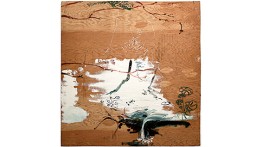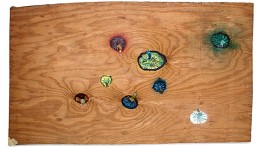Bill Lynch A'82 Gets Posthumous Debut Solo Exhibition; Rave Reviews
POSTED ON: October 20, 2014
Bill Lynch A'82, who died in 2013 after years of managing his schizophrenia, living on the margins and painting in relative obscurity, now has a posthumous solo exhibition (his first solo exhibition ever) in the West Village. The show has gotten notice in Artforum, The New Yorker, The Brooklyn Rail and a full review in The New York Times calling it "one of the season's sleepers." A fellow graduate of the School of Art, Verne Dawson A'80, who befriended Bill Lynch as a student, curated the exhibition. Located at the White Columns gallery, the show closes on October 25.
"Genius lands where genius will, and I’m pretty sure some alighted on Bill Lynch," begins the review by Roberta Smith in the October 18 edition of The New York Times. She continues, "his ineffably elegant, tender-tough paintings on salvaged plywood … are a delight, one of the season’s sleepers." The New Yorker calls them "dreamy, scruffy, beautiful paintings."
Lynch, who often incorporated the knots and grain of the wood into the composition, created images evoking the natural world of plants, animals and insects that reference Chinese and Japanese ceramics and scrollwork. "Euphorically ambiguous, in the same breath they celebrate Chinese Ming dynasty flower-and-bird compositions, which hold complex symbolization and interior resonance, and Mesoa-American shamanistic burial textiles," writes Andrianna Campbell in Artforum.
Bill Lynch was diagnosed with schizophrenia and "eked out a living" during his lifetime, according to the Times. The Brooklyn Rail reports, "though it appears that his output was prodigious, he was known to only a small coterie of other working artists and friends." After his death last year, due to throat cancer, a friend and fellow alumnus, Verne Dawson, curated the current exhibition. In a statement on the White Columns website, Dawson remembers their time together as students. "We both are in debt to the impossibly brilliant Professor Arthur Corwin for his vast knowledge of myth and astronomy, the subjects that bound Bill and I together for 35 years as well as the fundamental instinct to paint something beautiful," he writes. "Organizing this show in New York is surely a most bittersweet experience. It should have happened thirty years ago, or twenty, or ten, or five. But it didn't."







